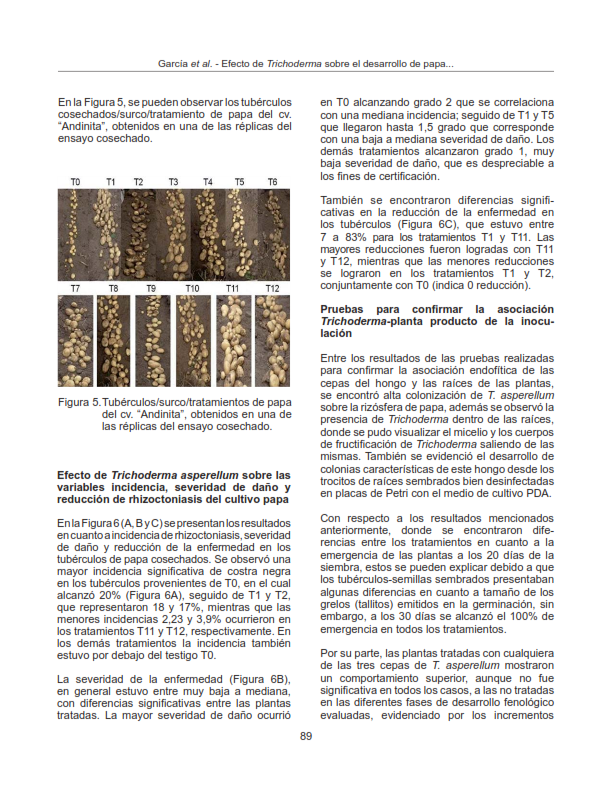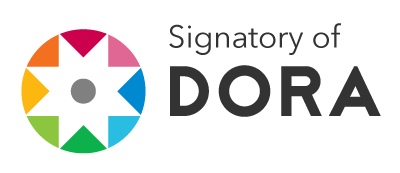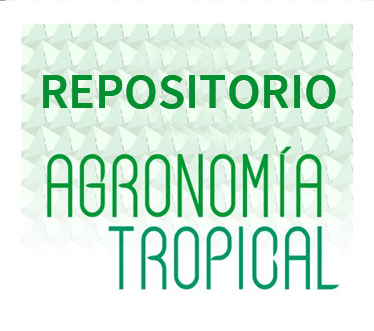Effect of Trichoderma on potato development and biocontrol of Rhizoctonia at three times from applying
Abstract
Rhizoctoniasis caused by the fungus Rhizoctonia solani Kühn, decreases potato yield. Seeking for environmentally and friendly alternative management of the disease, this study was conducted to evaluate the effect of Trichoderma on the development of potato, Solanum tuberosum L. and biocontrol of R. solani in the seed production process. Two replicas of a test cultivation house at Campo Experimental Mucuchíes, INIA-Merida were performed, under completely randomized design, where the application of three strains of Trichoderma asperellum (M-4, M-11, M-18, and their mixture) on potato plants cv “Andinita” was evaluated initiating at three different times: seed, furrow at planting and emergence of plants. Trichoderma treated plants showed significant increases in physiological variables (growth, photosynthesis) and yield; with low incidence, the severity of injury and rhizoctoniasis reduction in tubers maintained at all stages of development. The best responses were obtained with M-11 and the mixture, when the application is started in the emergence of plants, low incidences that were reached at 2.23 and 3.9%, grade 1 severity of the injury, disease reduction 83 and 80%, respectively, higher yields, ranging from 77.000 a 83.333 kg ha-1, compared with the control. The endophytic strain M-11 T. asperellum represents an alternative for the management of potato rhizoctoniasis crop for seed.
Downloads
References
• Aponte, O. 1986. Cuantificación de la enfermedad. Curso Internacional sobre enfermedades de cultivos y su control químico. Tomo I. Comisión de estudios de posgrado. Área fitopatología. Universidad Centroccidental Lisandro Alvarado (UCLA). Lara. Venezuela. 50 p.
• Cañizares, C. A. 2003. Estudio sobre poblaciones de hongos endofíticos provenientes de suelos supresivos al nematodo barrenador Radopholus similis (Cobb) Thorne en plantaciones de plátano en la zona de Talamanca, Costa Rica. Tesis M. Sc. Turrialba, CR. CATIE. 75 p.
• Carsolio, C., N. Benhamou, S. Haran, C. Cortez, A. Gutierrez and A. Herrera-Estrella. 1999. Role of the Trichoderma harzianum endochitinase gene, ech42, in mycoparasitism. Appl. Environ. Microbiol. 65:929-935.
• Chang, Y. C., Y. Chang, R. Baker, O. Kleifeld and I. Chet. 1986. Increased growth of plants in the presence of the biological control agent Trichoderma harzianum. Plant Dis. 70:145-148.
• Chet, I., J. Ibar and I. Hadar. 1997. Fungal antagonists and mycoparasites. In: The Mycota IV: Environmental and Microbial Relationships (Wicklow DT and Soderstrom B, eds.). New York: Springer Verlag. pp. 165-192.
• Chet, I., N. Benhamou and S. Haran. 1998. Mycoparasitism and lytic enzimes. In: Trichoderma and Gliocladium. Kubicek, C. P. y Harman, G. E. (eds). Taylor and Francis, Londres, Reino Unido. pp. 153-172.
• Contreras-Cornejo, H. A., L. Macías-Rodríguez, C. Cortés-Penagos and J. López-Bucio. 2009. Trichoderma virens, a plant beneficial fungus, enhances biomass production and promotes lateral root growth through an auxin-dependent mechanism in Arabidopsis. Plant Physiol. 149(3):1.579-1.592.
• Durman, S., A. Menéndez and A. Godeas. 1999. Evaluation of Trichoderma spp. as antagonistic of Rhizoctonia solani in vitro and as biocontrol in greenhouse tomato plants. Rev Argentina de Microbiología. 31(1):13-18.
• EL-Katatny, M. H., M. Gudelj, K. H. Robra, M. A. Elnaghy and G. M. Gübitz. 2001. Characterization of a chitinase and an endobeta-1,3- glucanase from Trichoderma harzianum Rifai T24 involved in control of the phytopathogen Sclerotium rolfsii. Appl. Microbiol. Biotechnol. 56(1-2):137-43.
• FAOSTAT. 2010. Venezuela Producción de Papa. Disponible en línea: https://bit.ly/3dbqObj [Consultado 10 de diciembre de 2010].
• García, R., A. García y C. Garnica. 1999.¡Cuidado con la rhizoctoniasis de la papa! Diario Frontera. Página Agropecuaria 5-C. Mérida. 3 de enero.
• García, R., A. García y J. Garnica. 2002. Distribución, Incidencia y Alternativas de Control de Rhizoctonia solani en el cultivo de la papa en el estado Mérida, Venezuela. Revista Latinoamericana de la papa. 13(1):24-40.
• García, R., R. Riera, C. Zambrano, A. García y A. Maggiorani. 2003. Evaluación de Trichoderma harzianum para el control de enfermedades fungosas desarrolladas en sistemas agrícolas merideños. In: Memorias del XVIII Congreso Venezolano de Fitopatología, Maracay, 12-14 de noviembre de 2003.
• García, R. y J. Salas. 2005. Aspectos generales del cultivo de la papa. In: García R.; J. Salas y G. Ramos. (Eds.). Producción de Semilla de Papa en Venezuela. Serie Manuales de Cultivo INIA N° 5. Mérida, Venezuela. INIA. pp.18-29.
• García, R., R. Riera, C. Zambrano y L. Gutiérrez. 2006. Desarrollo de un fungicida biológico a base de una cepa del hongo Trichoderma harzianum proveniente de la Región andina venezolana. FITOSANIDAD10(2):115-121.
• Goldman, G. H., C. Hayes y G. E. Harman. 1994. Molecular and cellular biology of biocontrol by Trichoderma spp. Trends Biotechnol.12(12):478-482.
• Gutiérrez, A. 2006. Estrategias para mejorar la comercialización de la papa en Venezuela ULA- FACES- CIAAL. Mérida, Venezuela. Disponible en línea: https://bit.ly/2J2rDFv. [Consultado: 20 de mayo de 2011].
• Harman, G. E. 2004. Mythos and dogmas of biocontrol. Changes in perceptions derived from research on Trichoderma harzianum T22. Plant Dis. 84:377-393.
• HowelL, C. R., L. E. Hanson, R. D. Stipanovic and L. S. Puckhaber. 2000. Induction of terpenoid synthesis in cotton roots and control of Rhizoctonia solani by seed treatment with Trichoderma virens .Phytopathol. 90(3):248-252.
• Hooker, W. 1980. Compendio de Enfermedades de la Papa. Centro Internacional de la Papa (CIP). Lima, Perú. 37-42 pp.
• Igarza, Y. 2011. Obtención de microtubérculos de papa (Solanum tuberosum L. subsp. andigenum) cv. ‘Andinita’ en Sistemas de Inmersión Temporal. Tesis doctoral. Escuela Socialista de Agricultura Tropical del Instituto Nacional de Investigaciones Agrícola. Doctorado en Biotecnología Agrícola, Mención Vegetal. Maracay, Venezuela. 130 p.
• Inbar, J., A. Menendez and I. Chet. 1996. Hyphal interactions between Trichoderma harzianum and Sclerotinia sclerotiorum and its role in biological control. Soil Biol. Biochem. 28(6):757-763.
• Instituto Nacional de Investigaciones Agrícolas (INIA). 2011. Manual de Agrometereología. Estadísticas Climáticas de Mucuchíes (Mimeografiado).
• Jakhar, S. S., M. S. Chauhan and J. C. Duhan. 1998. Management of root rot of cotton (Gossypium species) caused by Rhizoctonia species. Plant Dis. Res. 13(2):115-118.
• Jeffries, P. and T. W. K. Young. 1994. Biocontrol of Plant Pathogens. Interfungal Parasitic Relationships. CAB International, Wallingford. pp. 181-221.
• Jiménez, M. A. 2011. Evaluación de Trichoderma spp. y Acibenzolar-S-Metil (BION®) como induc- tores de resistencia a la pudrición blanca en ajo (Sclerotium cepivorum Berk). Tesis Doctoral. Maracay, Ven. Universidad Central de Venezuela. Facultad de Agronomía. 150 p.
• Korolev, N., D. D. Rav and Y. Elad. 2008. The role of phytohormones in basal resistance and Trichoderma-induced systemic resistance to Botrytis cinerea in Arabidopsis thaliana. BioControl. 53(4):667-683.
• Lewis, J. A. and G. C. Papavizas. 1991. Biocontrol of damping-off caused by Rhizoctonia solani in the field with formulations of Trichoderma spp. and Gliocladium virens. Crop Protection. 10(5):396-402.
• Mathivanan, N., K. Srinivasan and S. Chelliah. 2000. Biological control of soil-borne diseases of cotton, eggplant, okra and sunflower by Trichoderma viride. Z. Pflanzenk. Pflanzen. 107(3):235-244.
• Meneses, H. A. 2003. Utilización de hongos endofíticos provenientes de banano orgánico para el control biológico del nemátodo barrenador Radopholus similis (Cobb) Thorne. Tesis Msc. Turrialaba, CR. CATIE. 60 p.
• Menjivar, R. 2005. Estudio del potencial antagonista de hongos endofíticos para el biocontrol del nemátodo barrenador Radopholus similis en plantaciones de banano en Costa Rica, Tesis Msc. Turrialaba, CR. CATIE. 40 p.
• Molina de Paredes, O. y A. M. Contreras. 2009. Análisis de los métodos de cálculo. Visión gerencia. 8(1):103-113.
• Pocasangre, L. E., A. Zumfelde, A. Meneses, C. Cañizares, A. E. Riveros, F. Rosales and R. A. Sikora. 2004. Manejo alternativo de fitonematodos en banano y plátano. In: Memorias, XVI reunión Internacional de ACORBAT, Oaxaca, México. pp. 106-112.
• Reino, J. L., R. F. Guerrero, R. Hernández-Galán and I. G. Collado. 2008. Secundary metabolites from species of the biocontrol agent Trichoderma. Phytochem Rev. 7(1):89-123.
• Salazar, L. 1995. Los virus de la papa y su control. Centro Internacional de la Papa. Perú. 226 p.
• Van Wees, S. C., Van der Ent, S. and Pieterse, C. M. 2008. Plant immune responses triggered by beneficial microbes. Curr Opin Plant Biol. 11(4):443-448.
• Weindling, R. 1932. Trichoderma lignorum as a parasitic of other soil fungi. Phytopathology. 22:837-845.
• Yedidia, I., N. Benhamou and I. Chet. 1999. Induction of defence responses in cucumber plants (Cucumis sativus L.) by the biocontrol agent Trichoderma harzianum. Applied and Environmental Microbiology. 65(3):1.061-1.070.
• Yedidia, I., A. K. Srivastva, Y. Kapulnik and I. Chet. 2001. Effect of Trichoderma harzianum on Microelement Concentrations and Increased Growth of Cucumber Plants. Plant and Soil. 235(2):235-242.





